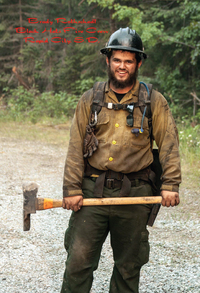For Brady Rothschadl, there was never a question about what he wanted to do with his life.
When he was a child growing up in Tyndall, he would hear the fire alarms go off and race down to the main street to see where the fire trucks were headed. From that point on, he knew he wanted to be a volunteer firefighter.
Rothschadl put that drive to use when he joined the Tyndall Volunteer Fire Department shortly after he turned 18 and was still in high school. He also took his EMT training during that time.
Upon graduation, he moved to Rapid City to attend Western Dakota Technical Institute to major in Fire Science. After graduating in 2014, he joined the Rapid City Black Hat Hand Crew.
According to Rothschadl, much of the crew’s work involves trying to minimize the damage caused by fires, especially during the summer months.
“When we’re not fighting fires, we go out to the hills and do field mitigation for people so their properties are safer fire-wise,” he explained. “We thin the trees out, cut them down so there isn’t so many, then we stack them in piles. After a year or two, we come back in the wintertime and burn those piles.”
The crew also fights fires not just in the Rapid City area, but anywhere in the country they’re called to.
“When there’s low fire danger (in the area), we are put on a national board so that other areas can request our assistance,” he said.
That’s happened quite a few times in Rothschadl’s three-year career. Just this spring alone, the Black Hat Hand Crew has been called to Reno County, Kansas, Wall, South Dakota, and Custer State Park. The crew was also called to Gatlinburg, Tennessee, in December.
“It was a pretty devastating fire, but the people there were thankful for us being there and helping the way we could,” he said.
One of the first fires he fought with the Black Hat Hand Crew was in Washington state, which took over 256,000 acres and was the largest fire in the state until the following year. Rothschadl rarely feels overwhelmed when his crew tackles fires of that magnitude.
“Other firefighters also get called in, so we’re tasked with securing one area of the fire and making sure it doesn’t spread,” he explained.
That involves using hand tools to dig lines around the fire and stop its progression by getting the fuels it’s burning out of the way so it will hopefully stop.
Water isn’t used very often, Rothschadl said.
Though the job is physically demanding with long hours spent in the heat, he knows he’s doing good work.
“It’s always rewarding knowing we helped someone by stopping the fire from burning too close to their property,” he said.



